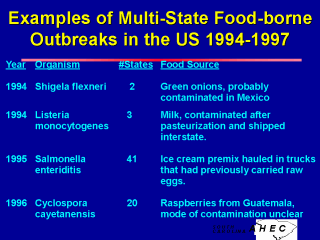| front |1 |2 |3 |4 |5 |6 |7 |8 |9 |10 |11 |12 |13 |14 |15 |16 |17 |18 |19 |20 |21 |22 |23 |24 |25 |26 |27 |28 |29 |30 |31 |32 |33 |34 |35 |review |
 |
Food-borne illnesses are common and the majority of cases go unreported, but each year millions of people in the US get sick from them and thousands die. Clusters of related symptoms/illnesses may go undetected if individuals do not seek medical care, individuals seeking care do not submit diagnostic stool cultures, a physician does not report a positive stool culture, or if individuals are treated at different sites and not recognized as part of a cluster. An ongoing surveillance system is needed to collect information about cases to determine if a public health concern exists. Some organisms are more easily transmitted and have more severe complications. Public health intervention is needed to prevent further spread. The US has had several multi-state food-borne outbreaks including those caused by Cyclospora parasites on fresh raspberries, hepatitis A virus on frozen strawberries, and Escherichia coli 0157:H7 bacteria in apple cider, lettuce, alfalfa sprouts, and ground beef. Changes in food processing and distribution have resulted in more multi-state outbreaks in the US. The National Food Safety Initiative was created in 1997 to address food safety problems in the US. Additional examples are listed on the next slide. |